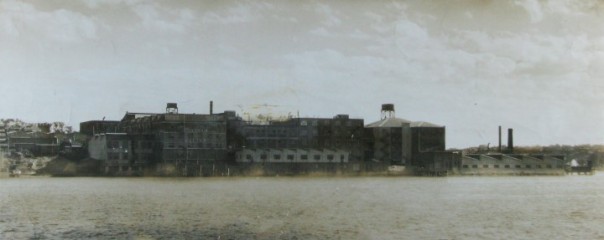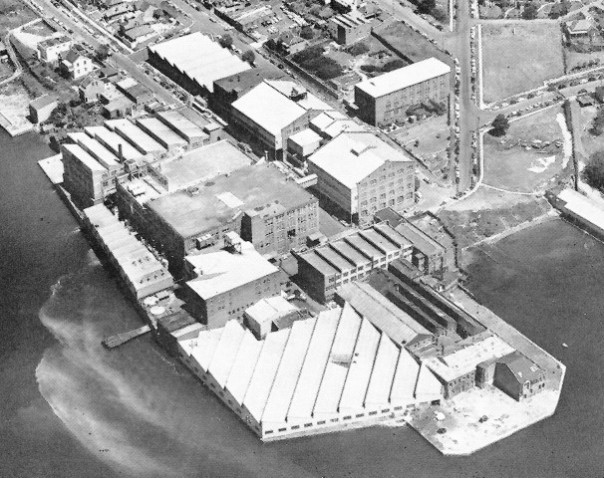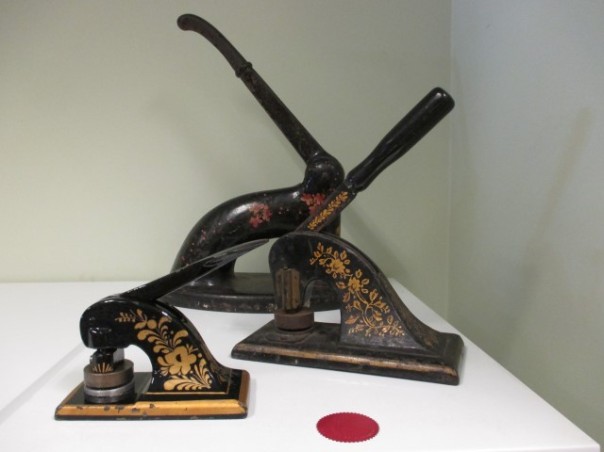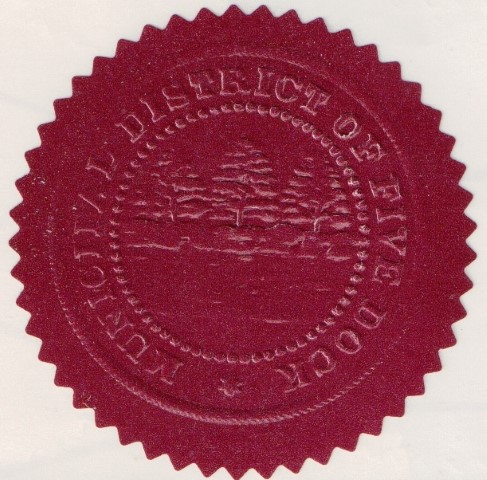Blog Archives
A strike for equality
During the Second World War women were called upon to fill the factory jobs left vacant by men who had enlisted in the armed forces. Their role became vital in ensuring that factories continued to operate and produce goods and materials essential for the war effort.
While women were expected to fill positions previously held by men, usually the pay was only about half the wages paid to men. In January 1942 forty women working in the shoe cutting department of Dunlop’s factory at Drummoyne went on strike for equal pay. They were amongst the pioneers of the movement for equal pay for women. The men had been paid £4 19 shillings 6 pence per week while the women were only receiving £2 14 shillings per week, with one junior female receiving just 26 shillings for her week’s work. The strike was ‘settled’ by a lift in wages, however, the women still only received 84 per cent of the male rate of pay.
In 1977 Dunlop closed its factory at Birkenhead Point and the site was redeveloped as Birkenhead Point Shopping Centre which opened for trading in 1979. Read more about the story of Dunlop at Birkenhead Point, below, under comments.
Memorabilia catalogued
Over recent months the library has been recording memorabilia held by the City of Canada Bay.
Memorabilia such as certificates and trophies provide a record of the activities and achievements of Council and staff. Details and, where possible, images of the memorabilia have been added to the library’s catalogue, making them easily accessible to the community and researchers.
The photograph, above, shows nineteenth century seal presses held in the Local Studies collection. These were used by City of Canada Bay’s predecessor Councils, the Municipality of Concord (rear), Municipal District of Five Dock (centre) and Municipality of Drummoyne (front). A seal press was used to add Council’s seal to official documents.
Below is the Municipal District of Five Dock seal which incorporates the ‘five docks’ of Council’s namesake. Five Dock takes its name from an unusual sandstone formation along the Parramatta River near Howley Park which was thought to resemble small docks. Two of the ‘docks’ were later covered by the construction of the first Gladesville Bridge in 1881. Interestingly, the seal also depicts trees which are presumably the same ones that can be seen at Howley Park today.
Going for gold
The latest exhibition at Five Dock Library highlights the remarkable achievements of Olympic swimmers associated with the Drummoyne Swimming Pool.
Many of the photographs are drawn from the collection of the Drummoyne Amateur Swimming Club which earlier this year entrusted their records to the Local Studies collection for safekeeping. Swimmers include Dawn Fraser, Jon Henricks, John and Ilsa Konrads and Shane Gould along with coaches of the calibre of Harry Gallagher and Forbes Carlile.
The photographs include some stunning images taken by noted photographer Ern McQuillan who at one time lived at Abbotsford. Ern grew up in the inner western suburbs of Sydney and began taking photographs as a boy with a box brownie camera. He went on to become a well known photographer for newspapers and magazines. Today his images are held by institutions such as the National Portrait Gallery, National Library and State Library of NSW.
The photograph above by Ern McQuillan shows Olympians Jon Henricks, Murray Rose and John Devitt.
Another smaller display in Local Studies at Concord Library celebrates local Olympian Lorraine Crapp.
Both displays are on view until the end of August 2016.
Discover Drummoyne
For those who missed seeing the ‘Discover Drummoyne’ display at the City of Canada Bay Museum, the panels are currently on display at Five Dock Library.
City of Canada Bay Museum has created a wonderful, informative and comprehensive exhibition exploring life in Drummoyne from early settlement through to recent times. The panels cover the magnificent mansions, booming factories, cultural venues, businesses, schools and famous people of Drummoyne through photographs and stories.
The photograph above shows Drummoyne from Parramatta River in 1911. It is one of a series of photographs held by the City of Canada Bay Museum which have recently been added to the City of Canada Bay Library Service online resource ‘Canada Bay Connections’, the source for many of the images in the display.
The display continues until 31 July 2016.
Drummoyne Amateur Swimming Club
For over one hundred years the Drummoyne Amateur Swimming Club has played an important part in the recreational life of our community.
The Drummoyne Amateur Swimming Club has had great success in fostering swimming not only at the local level but is associated with some of Australia’s greatest sporting achievements. Its history is studded with the names of famous swimmers, including Olympians Moss Christie, Dawn Fraser, Jon Henricks, John Konrads and Jan Murphy along with coaches of the calibre of Harry Gallagher and Forbes Carlile.
The longevity of the club owes much to the dedication of volunteers. During the Second World War sixteen year old Jack Hannaford combined the duties of Secretary and Treasurer when all the men were called up or in reserve forces. Such dedication was also exemplified by Bill Gallie OAM who in 1925 was Australian breaststroke champion. In 1964, aged 54, he moved from Balmain to Drummoyne and was volunteer coach and club secretary for almost twenty years.
The Drummoyne Amateur Swimming Club Records recently transferred its historical records and photographs to Local Studies for safekeeping and to ensure that their remarkable history is made available to researchers and the community.
A selection of the images will be exhibited later this year at Five Dock Library. The photograph, above, is of the Club Carnival night in 1981 at Drummoyne Swimming Pool.
Brothers in arms
While brothers from the same family often enlisted in the First World War, it was uncommon to see four brothers do so. At Drummoyne the Erickson brothers, Albert Victor, Roy Robert, Bertie Theodore and George Peter all enlisted to serve.
Educated at Drummoyne Public School, the Erickson brothers were keen sportsmen. All four swam with the Drummoyne Amateur Swimming Club, with Bertie (known as ‘Bert’) and George also playing in the Drummoyne Water Polo team. Albert’s other enthusiasm was Australian Rules Football, playing first for Drummoyne he then captained the Western Central team. Bert was also a rower with the Balmain Rowing Club.
Albert Victor Erickson, enlisted in August 1915 and served with the 3 Battalion, later transferring to the 45 Battalion. Roy Robert Erickson enlisted in July 1915 and served with the 18 Battalion. Tragically, Albert and Roy were killed in action within a day of one another in the Battle of Pozieres in France. Roy died on 5 August 1916, aged 19 years while Albert died on 6 August 1916, aged 23 years.
The photograph of the memorial plaques commemorating Albert Victor and Roy Robert was kindly donated to ‘Canada Bay Connections’ earlier this year by Ian Vinall.
A different view
Concord Library is currently featuring the work of artist Lilian Lai.
Included in the exhibition is a beautiful landscape featuring Gladesville Bridge.
Lilian comments on the painting, ‘The Gladesville Bridge is often forgotten with Sydney having the famous ‘coat hanger’. Many of us would never know that it is one of only four projects in Australia to receive the International Historic Civil Engineering Landmark, the world’s highest engineering award. For me, its sleek lines lends itself well into Sydney’s quite remarkable harbour landscape. I have painted this landscape in my contemporary xieyi (literally ‘writing intention’) style on Chinese rice paper mounted on canvas. I hope it conveys the economic beauty of this outstanding bridge in the midst of the harbour which is so much of Sydney.’
Lilian, who came from Malaysia to Sydney in 1988, is an active member of the Australian Chinese Painting Society and has exhibited widely, winning several awards for her work.
The paintings are on display at Concord Library until 28 February, then at Five Dock Library until 20 March 2016. Lilian’s workshop for children at Five Dock Library can be seen on flickr.
Seacombe Private Hospital
Seacombe Private Hospital was located at 16 Wolseley Street, Drummoyne. It was originally built as a large private home called ‘Seacombe’ in 1883.
The hospital was founded by Dr Guy Dixon Menzies and two of his medical colleagues, Dr Hugh Poate and Dr Wilfred Vickers in 1912. It operated for over forty years and, although the date of the hospital’s closure is uncertain, it was definitely still operating in 1954, as the noted author Miles Franklin died there in that year.
Dr Guy Menzies commenced in general practice in Plunkett Street, Drummoyne in 1896. Two of his sons, Guy Lambton Menzies (1909-1940) and Ian Lambton Menzies (1911-1941) died during the Second World War and Menzies Park at Drummoyne is named in honour of their sacrifice. Another son, Dr Bruce Lambton Menzies, followed in his father’s footsteps to become a highly regarded medical practitioner in Drummoyne.
The photograph shows Seacombe Private Hospital in the 1940s. While the building no longer exists, Seacombe Private Hospital often comes up amongst people researching their family history as the place where a relative was born or passed away.
Drummoyne Oval
An early photograph of Drummoyne Oval has recently been added to Canada Bay Connections.
Thanks to Phil Harvey (see comment below), the photograph has been identified as being taken prior to 1920 and shows the original grandstand.
The ‘Sports’ of the photograph is, of course, Rugby. Drummoyne Park was used for rugby games as early as 1882 when the area was part of William Wright’s estate.
Kevin Stutchbury kindly lent the photograph so it could be scanned and added to Canada Bay Connections.
St Bede’s Baseball Club, 1914
While baseball was first played in Australia in the nineteenth century, it was the visit of the American Fleet in 1908 that particularly boosted interest in the game. In that year baseball first began to be played in NSW schools.
By 1914 St Bede’s (Anglican Church), Drummoyne had a well organised baseball team. Players in the photograph, above, were back row: A. Norman (Pitcher), H. Kay (1st Base), L. Kay (Catcher), Honorary Treasurer E. Gordon (Centre Field); second row: F. Hall (3rd Base), A. E. Kelshaw (Short Stop), Captain A. Mackenzie (2nd Base), Vice Captain and Honorary Secretary E. Stutchbury (Right Field); front row: E. Boon (Left Field), A Parsons (Centre Field).
It appears that at least six of the young men enlisted in the First World War. Brothers Harold Brooks Kay and Leslie Frank Kay, Ernest Gordon, Frederick Poole Hall, Albert Edward Kelshaw and Eric William Stutchbury. Ernest Gordon was killed in action in 1917 but the others all returned to Australia after the war ended. Eric Stutchbury became a Major in the 55 Battalion and was highly decorated, being awarded a Military Cross with Bar.
The photograph of St Bede’s Baseball Club was recently donated to Local Studies by Major Stutchbury’s son, Kevin.











